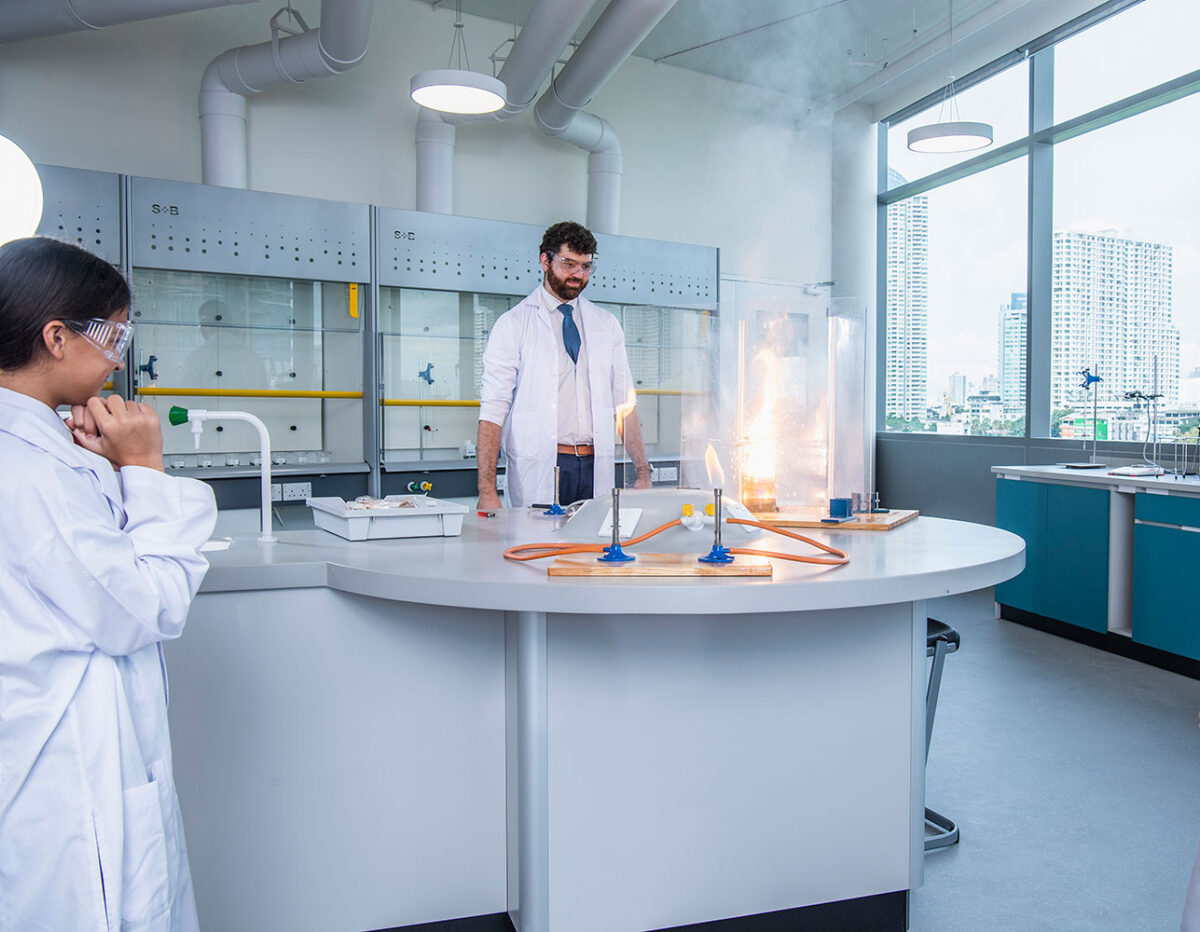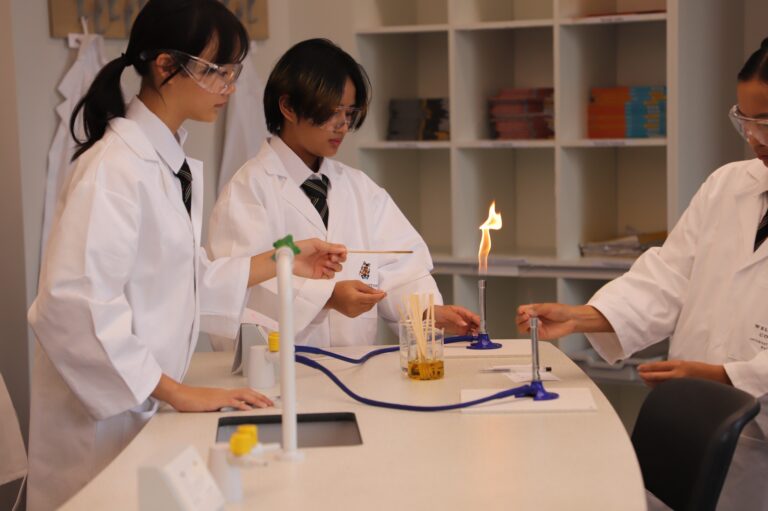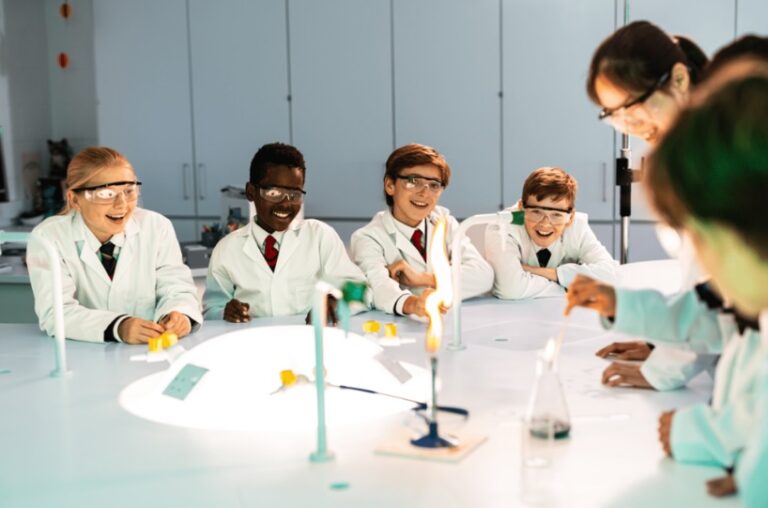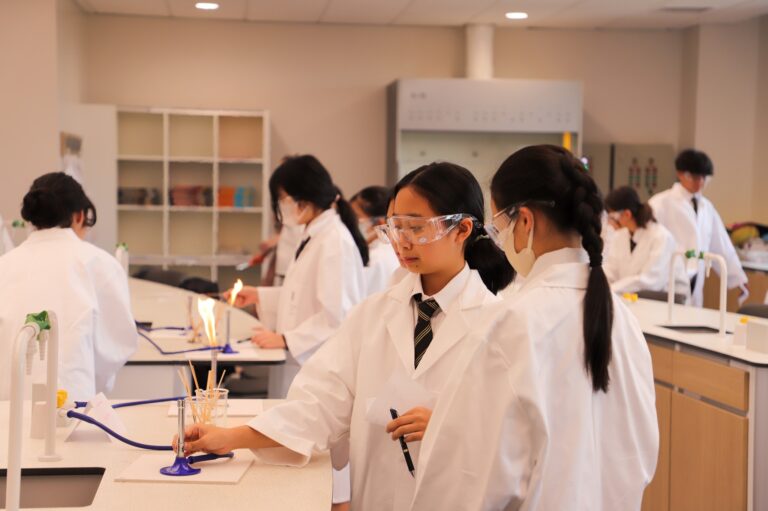This is a question we at S+B UK are frequently asked when beginning a school project—whether by builders, project managers, school owners/operators, or teachers, this question arises consistently.
S+B decided to consult the experts. Liam Serridge, S+B International Projects Manager, discusses this topic with Matt Endean, Deputy Director of CLEAPSS.
Firstly, it’s worth explaining who exactly CLEAPSS are for those who don’t know. Very briefly, CLEAPSS is a UK organisation funded by school and private organisation membership fees (not government funded) that provides advice to schools on carrying out practical science safely.
CLEAPSS has been in existence for over 60 years; 98% of secondary schools and 95% of primary schools in England, Wales, and Northern Ireland are members.
Liam Serridge is the International Projects Manager for S+B UK Ltd, working with schools and organisations all over the world to help design their ideal laboratory spaces.

Liam Serridge (left) and Matt Endean (right)
Turning our attention to the interview, let’s explore the questions and insights provided by our experts…
Liam: In very simple terms, does a high school need gas in their labs?
Matt: Although there are ways around it which we can discuss further, do you need gas to teach a full and rich curriculum? – Yes.
Liam: OK, well does it specifically say in the curriculum that gas is needed?
Matt: Well, let’s split that into two categories: the British curriculum and “others”.
For the British curriculum, it’s quite simple; there are “required practical’s” at GCSE and A level—practical experiments that the school has to sign off on to confirm the pupils have experienced. In all three sciences, there are practical’s where you would need to use a gas tap and a Bunsen burner to fulfil those requirements.
For other curriculums such as IB or IGCSE, there are no “required practical’s”, and therefore it’s not an absolute necessity. However, in our experience with the IB curriculum, there is a higher demand for practical work than in A level.
Therefore, schools naturally tend to use gas more often. Furthermore, with IB, pupils have more choice over their experiments, so some students could select experiments that do not require gas, but the opposite could also happen. So, if a school truly wants to offer these curriculums and provide their students with choice, they do need to enable the use of gas.
Liam: Is it true, or fair to say that gas is used in high schools more with the older students (say years 10 and 11) than the younger students in years 7, 8, and 9?
Matt: No, I would say if I’m honest, there’s a spike in the use of Bunsen burners in Year 7 when the students first enter high school. Think of it like an induction programme. If the students are entering science education at high school where they will be using gas, they need the induction first.
Teachers often use Bunsen burners a lot in that first year to get the students used to working with gas safely and equip them for the later years. Teachers also want to engage their students’ interest in science, and practical experiments using gas help to do that by making it exciting.
Liam: Okay, so just to reiterate, schools require gas from Year 7 onwards. What about primary or prep schools?
Matt: There is no requirement for gas in primary schools to meet any curriculum demands. In some prep schools or middle schools, they may start teaching Key Stage 3 early, in which case that would be equivalent to Year 7, and then yes, gas would be needed.
Liam: As a lab designer for schools worldwide, I frequently encounter challenges regarding gas availability, such as “unfortunately, we don’t have gas in our existing building” or “floor gas installation isn’t allowed due to local regulations”, etc.
In those situations, we develop clever solutions to deliver gas lines into labs, like using bottled gas or without running through the floor. I’m interested to hear your thoughts on these ideas.
Matt: Bottled gas is fine and is actually quite common. We recommend ensuring the gas cylinders are stored outside the building in a safe storage unit or cage (this is the law in the UK, so it’s a serious point). If using LPG gas, then the labs should have a low-level LPG alarm. This is because LPG is heavier than air, and therefore, if there is a leak, it will sink down. You wouldn’t be able to smell it until there is actually quite a lot of gas in the room, so a low-level LPG alarm is very important. Seek advice on this from local authorities.
To address the second part of your question, regarding avoiding gas pipes running through the floor, we’ve seen droppers coming down from the ceiling. From my experience working with thousands of schools and as a former teacher myself, I strongly advise against this at all costs. It ruins sight lines, and although the idea may not sound too intrusive initially, you don’t realize how problematic it is until you’ve experienced teaching in such an environment. I have yet to encounter a school that is satisfied with a drop-down pillar system.
Liam: Yes, our experience is the same. Installing drop-down pillars or fold-down arms has often left end users dissatisfied, so we now tend to advise against them.
An alternative is to create peninsulas along walls, allowing gas pipes to run behind fixed cabinetry at low level and then branch out to serve student gas taps. However, this setup requires fixed benching, which contrasts with the current preference for flexible furniture solutions.
Matt: Yes, well, although lots of teachers love the idea of “flexibility”, especially in the design phase, the reality is that once a lab has been set up in the layout the teacher chooses to use, it rarely ever gets moved again.
Liam: Agreed. When we consider using gas, naked flames, burning liquids, corrosive chemicals, all in a room full of teenagers – do we really want all these resting on loose tables that can easily be knocked over, resulting in a nasty accident? Or do we want them on a secure, sturdy work surface which prioritises student movement as flexibility over furniture movement?
Returning to the topic of gas in labs, another common query is about the proximity of gas taps to electrical sockets.
Matt: In the UK, there are no regulations against this, and it’s the same for water. I can see why someone might naturally be concerned about it, but all electrical supplies should be RCD protected as standard according to building regulations. An ideal situation, and something we would recommend, is that all three services (gas, water, electricity) should have shut-off switches centrally located near the teacher’s station.
These switches should be considered “enablers” rather than “emergency shut-off” systems, so they should all remain off by default and only turned on independently as and when needed. But generally speaking, there are plenty of things that cause issues in science labs, and the proximity of gas taps to electrical sockets isn’t one of them.
Liam: How about sprinkler systems in labs due to gas being present? Are these recommended?
Matt: Again, this isn’t really within CLEAPSS’s advisory scope, as it falls under the school’s fire risk assessments required by law. If the risk assessment conducted by the employer determines that sprinkler systems or any other fire extinguishing system is necessary, then it will be included in the regulations and permits for that school. One thing to note about sprinkler systems is that they should not be installed in chemical stores where water-reactive chemicals are likely stored.
Liam: Returning to the topic of gas provisions in labs, do some subjects require gas more than others, like Chemistry compared to Physics? Occasionally, clients with tight budgets suggest installing only 2 or 3 gas taps in the Physics room where they’re less needed. In your opinion, is this a practical solution?
Matt: In my opinion, having just a few gas taps in a full lab is a bit pointless. The only time it might be justified is if there was just a single gas tap on the teacher’s desk for demonstration purposes. But if you’re going to provide gas outlets for the students, you should either provide enough for all students to use or omit them entirely.
I can understand that a school might have three labs—two with gas (Chemistry and Biology) and one without (Physics)—if they are working within a budget. However, some Physics experiments require gas, and I’m not just talking about heat—they actually need a naked flame, so they need burning gas and a Bunsen burner. Therefore, if they do have one lab without gas, the school will need to accept the necessity of scheduling and rotating classes to allow Physics lessons in the Chemistry or Biology labs that have gas.
Liam: So ultimately the notion that Physics doesn’t need gas is actually not true, but it is correct that it is used less so than in Chemistry and Biology?
Matt: Yes, and another important point which many people don’t realise is how often Bunsen burners are needed in Biology! At least 25%, maybe 35%, of the biology curriculum is microbiology (and growing). To do microbiology work, you need a sterile environment, and the only way to achieve this in a high school lab is by using a Bunsen burner to create an updraft. There are no viable alternatives, so alternatives such as hot plates unfortunately can’t fully replace Bunsen burners for microbiology work.
Liam: Finally, we’ve mentioned alternatives to gas and Bunsen burners, such as electric hot plates or Campingaz stoves. Some of my clients consider using these instead of installing gas. Do you have any advice on the safety and suitability of these alternatives?
Matt: Yes, certainly in the UK, a Campingaz type gas cylinder which has a Bunsen burner stem adapted to attach to the canister is technically illegal. If you read the fine print on the cylinder, it states that only approved fittings can be connected to the cylinder. No cylinder manufacturer makes a Bunsen burner fitting, and therefore they are not approved. But that isn’t the real risk, the real risk is having several loose canisters of gas in a school environment which students are lighting. If they accidentally drop one on the floor, it’s likely to land on the chimney of the Bunsen.
The cylinder could then quite easily shear and essentially create a huge fireball in the room. There is a range of portable Bunsens (see CLEAPSS Guide GL240) which can be used in temporary situations (where the gas is cut off for works); however, these are not a long-term solution. We also carried out a study which established that a typical UK school would need to hire a full-time member of staff just to refill all the empty gas cylinders with these portable Bunsens.
As for hot plates or ‘electric’ Bunsens, yes, these can be used for various experiments, but for reasons explained earlier, they still can’t fully replace the gas Bunsen. They are often considered a cheaper option to installing gas, which I think is debatable. If you consider they have a lifespan of around 5 years (if you’re lucky), if you drop one on the floor it’s likely to break, they cost up to £800 each, and require quite a lot of electrical power. A Bunsen burner costs around £20 each and would last a lifetime, as would a mains gas installation.
In summary, while alternatives exist, gas remains a crucial component for fulfilling the educational needs in school science labs. The insights shared by the experts highlight the importance of proper gas installations to ensure a comprehensive and effective science curriculum.
If you’re renovating or building new labs, prioritize essential elements for a rich and safe learning environment. For personalized advice, contact experts like Liam Serridge and Matt Endean to help design labs that meet high educational and safety standards.




